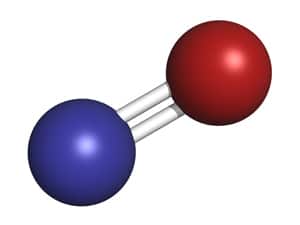
How It’s Used
Nitric oxide (aka nitrogen oxide, nitrogen monoxide, mononitrogen monoxide) is a colorless, nonflammable, poisonous, oxidizing gas with an irritating odor. The compound is a free radical: Its bonding structure includes an unpaired electron. Its name is sometimes confused with nitrous oxide. Nitrous oxide—N2O—is the sedative (laughing gas) and motor fuel additive. Here, though, we are discussing NO, nitRIC oxide.
Nitric oxide has few direct industrial applications, although it is produced as an intermediate in the Ostwald process (synthesis of nitric acid from ammonia). It is utilized in the semiconductor industry (to form oxynitride gates in CMOS devices), and there are sundry medical uses of the compound. Since the gas is an unavoidable product of combustion, it is generated as a pollutant in many processes.
Occupational Health/Toxicology
Inhalation of higher than average environmental levels of nitric oxide (conversion occurs to nitrogen dioxide in ambient air) can cause respiratory problems, particularly in sensitive individuals such as asthmatics. Higher concentrations can result in severe respiratory symptoms and cyanosis. An asphyxial death can occur due to blockade of gas exchange in the lungs.
Full record on nitric oxide from Hazardous Substances Data Bank (HSDB), a database provided by the US National Library of Medicine.
The nitric oxide entry from NIOSH’s Pocket Guide to Chemical Hazards.
Monitoring Instrumentation
Check out Interscan’s full line of nitric oxide gas detection/gas monitoring instrumentation.
